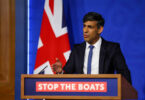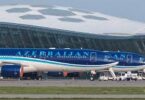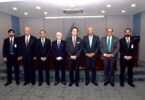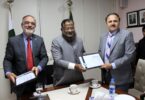Ankit Panda
Despite North Korea’s low profile throughout the coronavirus pandemic so far, the country’s nuclear and missile programs have hummed along. Now, as U.S. President-elect Joe Biden prepares to enter the White House, North Korea may accelerate its plans.
Last week, North Korea convened the Eighth Party Congress of its ruling party, only the second such event in the past four decades; the Seventh Party Congress took place in 2016 after a thirty-six-year gap. These party congresses represent the authoritative apex of North Korean state decisionmaking and cover everything from leadership matters and economic policymaking to military plans. At the most recent gathering, Supreme Leader Kim Jong Un outlined a set of ambitious, wide-ranging, and multifaceted nuclear modernization plans—the most extensive such plans that North Korea has presented in years. Kim discussed missiles compatible with multiple reentry vehicles, solid propellant intercontinental ballistic missiles (ICBMs), tactical nuclear weapons, military reconnaissance satellites, and new unmanned aerial systems, among others.
The report likely signals that North Korea is poised to resume weapons testing, as Pyongyang did in 2016 and 2017. At the same time, Kim is positioning himself for negotiations with the incoming Biden administration by communicating that, absent a shift in U.S. policy, his country’s qualitative nuclear force modernization will continue apace but may even sharply accelerate. While de-escalating tensions with Iran and salvaging the 2010 New START Treaty with Russia will be immediate priorities for the Biden administration, avoiding a renewed crisis on the Korean Peninsula will require swift diplomatic outreach.
Going big by going going small: One of Kim’s leading aims confirmed by these recently unveiled plans is to pursue tactical nuclear weapons. To date and to the best of U.S. analysts’ knowledge, North Korea has not yet pursued tactical (nonstrategic) nuclear weapons. These are generally shorter-range, lower-yield nuclear systems meant for use on the battlefield against military targets. North Korea’s development of such weapons would increase the nuclear dangers at play on the Korean Peninsula.
The comprehensive work report explicitly noted the “development of ultra-modern tactical nuclear weapons.” It identified “new type tactical rockets”—presumably, the KN23, KN24, and KN25 short-range missiles tested in 2019 and 2020—and “intermediate-range cruise missiles” as the delivery platforms for these new nuclear weapons. Kim further called for new nuclear weapons that would be “smaller and lighter for more tactical uses.”
Tactical nuclear weapons have a storied history on the Korean Peninsula. The United States based a variety of these weapons on the peninsula between 1958 and December 1991. The removal of those weapons in 1991 under former president George H.W. Bush’s Presidential Nuclear Initiatives was an important enabling condition for the January 1992 inter-Korean denuclearization accord, which (among other achievements) introduced the phrase “denuclearization of the Korean Peninsula” to the international diplomatic lexicon.
North Korea, however, never publicly acknowledged that South Korean soil had been denuclearized after December 1991. On occasions, North Korean state media has intimated that tactical nuclear weapons continue to be stationed in South Korea—as a disingenuous way to justify Pyongyang’s possession of nuclear weapons. In September 2017, at the height of U.S.–North Korea tensions, North Korea’s official party newspaper Rodong Sinmun falsely claimed the United States had conducted a “tactical nuclear bomb test in Nevada”—in reality, it was a drop test of an inert B61-12 gravity bomb. In the meantime, South Korean conservatives have expressed an interest in bringing U.S. tactical nuclear weapons back to South Korea to offset North Korea’s nuclear capabilities. In 2017, the conservative Liberty Korea Party reportedly touted its interest in the “redeployment of tactical nuclear weapons on the Korean Peninsula” in its party platform.
Yet, in practical terms, Pyongyang’s stated interest in such weapons is not particularly surprising. To date, North Korea has postured that it would use nuclear weapons first if its national sovereignty is threatened. In effect, if its conventionally superior adversaries—the United States and South Korea—ever initiated an attack, Pyongyang has indicated it would employ nuclear weapons against military targets to try to degrade and ultimately defeat any invasion attempt. With the development of longer-range systems, including ICBMs, Pyongyang could then hold at risk major population centers in the continental United States and in Northeast Asia to deter further escalation and terminate a conflict on terms favorable to the regime (while preserving Kim’s life). North Korea’s older Scud-variant missiles would likely have served as delivery systems for an initial nuclear strike. By comparison, new systems like the KN23, KN24, and KN25, if armed with tactical nuclear warheads, would prove more survivable and responsive in a crisis. Tactical nuclear weapons could make the front end of this strategy more credible, while introducing new risks.
For instance, many of these risks concern possible changes to North Korea’s nuclear command and control. So far, Kim appears to have a strong preference for assertive control over his nuclear forces, meaning that the authority to launch nuclear weapons is vested with only him and certainly not with the North Korean military. Despite this established chain of command, tactical nuclear weapons could create pressures for delegating such authority in peacetime or in a crisis. Separately, tactical nuclear warheads would likely be dispersed around North Korea, creating new proliferation and safety challenges. These warheads may, for example, be mated to their delivery systems in peacetime, unlike North Korea’s strategic nuclear warheads. If North Korea’s political regime were to collapse, these weapons would also complicate contingency planning for securing North Korea’s weapons.
Even if North Korea opts to keep tactical nuclear weapons in central storage during peacetime, in a crisis, Kim may face added pressures to delegate lau-nch authority—pressures t-hat may increase the chan-ces of inadvertent or unauthorized nuclear use on or around the Korean Penin-sula. (In such scenarios, Ki-m could conceivably have an incentive to delegate launch authority as a signal to adversaries that an attack designed to eliminate him personally would not forestall a nuclear response.)
A final risk concerns renewed nuclear testing. North Korea remains the only state to have tested nuclear weapons in the twenty-first century, having conducted six tests between October 2006 and September 2017. While the design knowledge about nuclear weapons Pyongyang has gained from these six tests may be sufficient for the serial production of lower-yield, compact warheads for tactical nuclear weapons, North Korea could alternatively seek to resume nuclear testing to pursue more efficient lower-yield weapons.
Nuclear testing aside, North Korea has shifted its attention in recent years to shorter-range systems that could make ideal delivery systems for tactical nuclear weapons. To recap, except for an October 2019 submarine-launched ballistic missile test, Kim has otherwise refrained from nuclear and long-range missile testing since November 2017. After the Hanoi summit in February 2019, his attention shifted to extensively testing a new suite of short-range missile systems. Twenty-five of these missiles were tested that year, leaving 2019 as the busiest missile-testing year in North Korean history. (These figures are based on a private database used by the author.) The administration of U.S. President Donald Trump largely ignored these tests even though they violated UN Security Council resolutions.
In December 2019, amid a diplomatic impasse, Kim explicitly renounced his April 2018 moratorium on long-range missile and nuclear testing, putting this possibility back on the table. Meanwhile, the way North Korea dismantled the Punggye-ri nuclear test site in May 2018 would allow Pyongyang to quickly rebuild it for renewed nuclear testing. The biggest factor weighing against renewed nuclear testing is arguably China. The sharp improvement in Sino–North Korean relations since the March 2018 meeting between Chinese President Xi Jinping and Kim might quickly evaporate if Pyongyang were to resume nuclear tests. A new missile testing campaign?
Tactical nuclear weapons aren’t the only capability North Korea may seek to test. The Party Congress report was explicit that North Korean national defense scientists are “making preparations” for the test and production of multiple reentry vehicles as well as “hypersonic gliding flight warheads.” Like tactical nuclear weapons, each would represent qualitatively new developments for North Korea’s nuclear forces. Given the authoritative forum in which this assertion was made, these claims deserve to be taken seriously. Both technologies would contribute to North Korean confidence that existing U.S. and South Korean missile defenses may not be impenetrable. Multiple reentry vehicles, furthermore, would be a cost-effective way to grow Kim’s force size because, on balance, warheads should be cheaper for North Korea to produce than additional delivery systems.
The pandemic seems to have disrupted or delayed these plans, at least for now. In December 2019, just weeks before North Korea enacted a national lockdown that has yet to end, Kim had promised “shocking actual actions” as part of his report to the ruling party’s Fifth Plenary Meeting of the Seventh Central Committee. At the time, that promise likely corresponded to planned strategic weapons testing—especially as the plenum was preceded by two liquid propellant engine tests at Sohae. In that same address, Kim also promised to reveal a “new strategic weapon,” which later turned out to be a new eleven-axle, extra-large ICBM unveiled at North Korea’s October 2020 military parade.
In the 2020 of an alternate universe where North Korea had not limited its military activities because of the coronavirus pandemic, the world may have already seen this sort of testing. But now, with a new U.S. administration set to enter office and an authoritative promise to test, the odds of a new North Korean missile testing campaign resembling that of 2016 and 2017 have grown considerably. Both of Biden’s predecessors were welcomed into office with prominent North Korean testing, a pattern that may yet hold. These North Korean demonstrations early in a new U.S. president’s term allow Pyongyang to not only ensure its place on the national security agenda in Washington but also build leverage ahead of any possible diplomatic negotiations.
Implication for a US policy review: This is the state of play that the U.S. president-elect will have to contend with. If the Biden administration maintains the status quo of economic sanctions on Pyongyang while insisting on the comprehensive, verifiable, and irreversible dismantlement of the totality of its nuclear forces, North Korea will likely up the ante by slowly but surely testing qualitatively new weapons systems. Through these tests, North Korea will aim to build leverage before entering negotiations with the United States. In effect, Pyongyang seeks to ask a Biden administration if it would rather negotiate with a North Korea that merely possesses thermonuclear weapons and operationally suboptimal liquid propellant–fueled ICBMs or instead sit down a few years from now to discuss Pyongyang’s multiple reentry vehicles and tactical nuclear weapons.
Kim was far more chipper recounting these nuclear modernization plans earlier in January 2021 than he was when he dourly recounted North Korea’s tremendous economic difficulties, which started in 2019 and only accelerated amid the pandemic in 2020. Under these constraints, perhaps North Korea’s near-term modernization plans are a check that cannot be cashed. The new U.S. administration could call Pyongyang’s bluff, but doing so would be risky. Previous administrations have underestimated North Korea at their peril, and Kim’s past pledges to push through successive qualitative breakthroughs—a first ICBM test in July 2017, a first thermonuclear weapon test in September 2017, and so forth—have not been bluster.
If Biden takes Kim’s agenda at face value, the case for a fundamental rethink of current U.S. policy grows stronger. Ever since Trump’s Singapore summit with Kim in June 2018, North Korea has indicated its interest in negotiations that would be more akin to arms control talks than the unilateral disarmament negotiations of the past. In practical terms, the Biden administration can emphasize a continued need for North Korea to refrain from further weapons testing. But these exhortations alone are unlikely to bear fruit without inducements for Pyongyang to exercise restraint. The administration should still carry out a comprehensive and careful policy review while consulting with Seoul, but Biden should make clear as soon as possible that Pyongyang can expect a new approach. This should include a willingness to offer limited and reversible relief from UN Security Council sanctions in exchange for meaningful restraint on weapons testing, for example.
Despite the broad and complex nuclear policy agenda facing the Biden administration beginning at noon on January 20, the urgency of taking swift action on North Korea cannot be overlooked.






